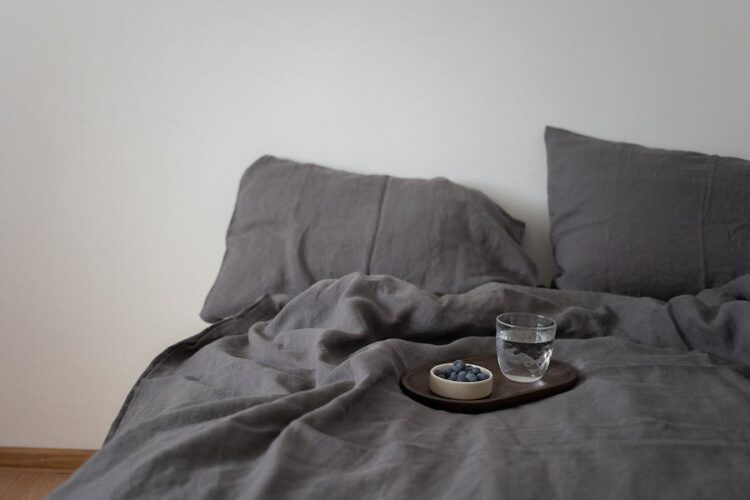A good night’s sleep is essential for overall well-being, and the right mattress can play a crucial role in achieving it. Among the many mattress options available, waterbeds have gained attention for their unique design and potential benefits, especially for back health. However, the question remains: Are waterbeds good for your back? In this article, we will delve into the mechanics of waterbeds, explore their potential advantages and drawbacks about back support, and offer guidance for those considering this unconventional mattress option. Whether you’re seeking relief from chronic back pain or simply curious about alternative bedding choices, read on to make an informed decision about the impact of waterbeds on your back’s well-being.
Are Waterbeds Good For Your Back?
Waterbeds can offer benefits and drawbacks for your back, depending on your specific needs and preferences. The advantages of waterbeds include their ability to distribute weight evenly, reduce pressure points, and provide customizable firmness, potentially promoting spinal alignment. However, they may only be suitable for some, as maintenance and durability can be concerns, and some people may be bothered by motion disturbances. Whether a waterbed suits your back depends on your comfort and support requirements and any existing back conditions. Consider these factors and possibly try out a waterbed before deciding.
The Benefits Of Waterbeds For Back Health
The benefits of waterbeds for back health are worth exploring, as they offer a unique sleeping experience that can be advantageous for some individuals. Here are some of the key benefits:
Even Weight Distribution: Waterbeds distribute body weight evenly, reducing pressure points on the body. This can help alleviate discomfort and reduce the risk of developing pressure ulcers, making waterbeds a potential choice for those with back pain or sensitivity.
Customizable Firmness: One of the most significant advantages of waterbeds is the ability to customize their firmness to suit individual preferences. By adjusting the water level, users can achieve the desired level of support and comfort, which can be particularly beneficial for individuals with specific back conditions.
Spinal Alignment: Proper spinal alignment is crucial for back health, and waterbeds are designed to support the spine’s natural curvature. This can help maintain a healthy posture during sleep, potentially reducing back pain and discomfort.
Temperature Control: Some waterbeds have temperature control features, allowing users to adjust the water’s warmth. This can be beneficial for relaxing muscles and relieving tension, which is especially valuable for individuals who experience muscle stiffness or backaches.
Reduced Motion Transfer: Waterbeds can offer reduced motion transfer compared to traditional innerspring mattresses. This means that movements on one side of the bed are less likely to disturb a partner on the other side, improving sleep quality for couples.
Pressure Point Relief: Waterbeds conform to the body’s shape, reducing pressure points that can lead to discomfort or exacerbate existing back pain. This can be especially beneficial for individuals with sciatica or herniated discs.
Longevity And Durability: High-quality waterbeds can have a long lifespan, potentially lasting many years with proper care. This longevity can provide consistent support for your back over an extended period.
Allergen Resistance: Waterbeds are less susceptible to allergens like dust mites and mold because they lack the traditional cushioning materials where these allergens can thrive. This can be advantageous for individuals with allergies or respiratory issues.
Ease Of Cleaning: Cleaning a waterbed is relatively straightforward. You can easily wipe down the waterproof vinyl surface to maintain hygiene, which can be particularly useful for those concerned about cleanliness and sanitation.
Pain Relief: Some individuals with chronic back pain conditions, such as fibromyalgia or arthritis, have reported finding relief from their symptoms with waterbeds. Combining support, pressure relief, and temperature control can contribute to pain management.
Potential Drawbacks Of Waterbeds For Back Health
Waterbeds necessitate regular maintenance to ensure they remain in optimal condition. This includes checking for leaks, disrupting sleep, and damaging the mattress and surrounding furniture. Locating and repairing leaks can be time-consuming and require draining and refilling the mattress.
Waterbeds are susceptible to motion disturbances, particularly wave-like movements caused by one person’s shifts or movements. This can be a significant concern for couples, as one person’s actions can disrupt the other’s sleep. Soft-sided waterbeds with waveless designs can mitigate this issue.
Once filled with water, waterbeds can be heavy and challenging to move. This poses logistical challenges during assembly, disassembly, or relocation. It’s essential to have a sturdy bed frame that can adequately support the weight of a waterbed to prevent sagging or damage.
While waterbeds are generally resistant to dust mites due to their waterproof vinyl surface, they can still be susceptible to mold or mildew growth if not adequately maintained. Cleaning and maintaining the vinyl surface and regularly checking for any signs of moisture or mold are essential to prevent these hygiene issues.
While controlling the waterbed’s temperature can be an advantage but can pose challenges. If the waterbed’s temperature is not set correctly, it can lead to discomfort. For instance, too-warm water can cause overheating, while too-cold water can be chilly and uncomfortable, especially in cooler climates.
Waterbeds often lack the edge support found in other types of mattresses. This means that sitting or sleeping near the edges of the bed may be less comfortable or stable. Some individuals may find it challenging to get in and out of bed or sit on the edge without feeling supported.
Many people find it takes time to adjust to sleeping on a waterbed. The sensation of floating on water can be unfamiliar and may require a period of adaptation to achieve optimal comfort. Some individuals may initially experience discomfort or unease.
The Different Types Of Waterbeds
Waterbeds come in various types, each offering distinct features and benefits. Here’s a detailed overview of the different types of waterbeds:
Hard-Sided Waterbeds:
Hard-sided waterbeds are traditional and have a water-filled mattress in a rectangular wooden frame. The frame provides structural support and helps contain the water mattress. These waterbeds are known for their durability and stability but can be heavy and challenging to move due to the frame’s weight. They come in various sizes, including king, queen, and single.
Soft-Sided Waterbeds:
Soft-sided waterbeds are a more modern variation designed to resemble conventional mattresses. Instead of a rigid wooden frame, they have foam or fiber-filled sides that encase the water mattress. This design makes them lighter and easier to manage than hard-sided waterbeds. Soft-sided waterbeds often include additional comfort layers on top of the water mattress for enhanced support and comfort.
Waveless Waterbeds:
Waveless waterbeds are designed to minimize the motion disturbances associated with traditional waterbeds. They achieve this by incorporating wave-reducing technologies like fiber or foam baffles within the water mattress. These baffles restrict water flow, reducing the ripple effect when one person moves on the bed. Waveless waterbeds offer a more stable and motion-isolated sleeping surface.
Semi-Waveless Waterbeds:
Semi-waveless waterbeds balance the traditional waterbed and the waveless variety. They have fewer baffles than waveless waterbeds, allowing for some degree of wave movement while offering improved motion isolation compared to a standard waterbed. This type is suitable for those who want a compromise between a traditional waterbed’s free-flow feel and a waveless one’s stability.
Hybrid Waterbeds:
Hybrid waterbeds combine water chambers with other materials, such as innerspring coils or foam layers, to create a mattress that blends waterbeds’ benefits with traditional mattresses’ comfort and support. These hybrids aim to provide a more familiar and comfortable sleep experience while retaining waterbeds’ advantages, like temperature control and pressure relief.
Softsided Hybrid Waterbeds:
These hybrids combine the soft-sided design of modern waterbeds with additional comfort layers, such as memory foam or latex, to offer a luxurious and supportive sleeping surface. They often come with adjustable firmness options and are a popular choice among those seeking a balance between waterbeds’ benefits and traditional mattresses’ familiarity.
Free-Flow Waterbeds:
Traditional free-flow waterbeds have minimal internal baffles, allowing for a free, undisturbed water flow. These beds offer the classic waterbed sensation of floating on water but can be prone to motion disturbances. They are most suitable for individuals who enjoy the distinct feel of a waterbed.
Waveless Lumbar Support Waterbeds:
These waterbeds feature additional fiber or foam layers in the lumbar area to provide targeted support to the lower back. This design aims to alleviate back pain and promote spinal alignment, making them a choice for individuals with specific back issues.
Tips For Choosing And Using A Waterbed
Choosing and using a waterbed effectively involves several considerations to ensure comfort, support, and longevity. Here are some tips to help you make an informed decision and maintain your waterbed:
Choosing A Waterbed:
- Assess Your Needs: Determine your specific comfort and support requirements. Consider any existing back conditions or preferences for firmness levels.
- Research Types: Explore the different types of waterbeds, such as hard-sided, soft-sided, waveless, or hybrid options. Each type offers unique features and advantages.
- Quality Matters: Invest in a high-quality waterbed with a durable vinyl mattress. Look for reputable brands and read customer reviews to gauge product satisfaction.
- Warranty And Guarantees: Check the manufacturer’s or retailer’s warranty and return policy and ensure you understand the terms and coverage.
- Try Before You Buy: You can assess a waterbed’s comfort and suitability for your needs by trying it out in a showroom or during a trial period.
Setting Up And Using A Waterbed:
- Follow Instructions: Carefully read and follow the manufacturer’s instructions for filling, draining, and maintaining your waterbed. Improper setup can lead to discomfort and damage.
- Proper Support: Ensure that your waterbed is placed on a stable and adequately supported bed frame designed for waterbeds. Adequate support is crucial to prevent sagging or damage.
- Adjust Firmness: Experiment with the water level to achieve your desired firmness. It’s a key benefit of waterbeds, so take the time to find the right balance for your comfort.
- Regular Maintenance: Inspect your waterbed regularly for leaks or punctures. Address any issues promptly to prevent disruptions in sleep and damage to the mattress.
- Hygiene And Cleaning: Clean the vinyl surface of the waterbed regularly to prevent mold or mildew growth. Use manufacturer-recommended cleaning products and techniques.
Final Words
Waterbeds offer a unique sleeping experience with potential benefits for back health. Their ability to distribute weight evenly, provide customizable firmness, and support spinal alignment can be advantageous for individuals seeking relief from back pain or discomfort. However, it’s crucial to consider the potential drawbacks, such as maintenance requirements, motion disturbance, and weight considerations, before deciding if a waterbed is the right choice for you. Ultimately, the suitability of a waterbed for your back health depends on your individual needs, preferences, and any specific back conditions you may have. It’s advisable to consult with healthcare professionals and explore different waterbed types and alternative mattress options to make an informed decision that ensures a comfortable and supportive night’s sleep while prioritizing your back’s well-being.
FAQ’s
What Type Of Waterbed Is Best For Back Support?
The best type of waterbed for back support depends on individual preferences. Some may prefer waveless waterbeds with reduced motion, while others may opt for soft-sided hybrids that combine water chambers with additional comfort layers for enhanced support.
How Do I Maintain A Waterbed For Optimal Back Health?
Proper maintenance involves regularly checking for leaks, adjusting water levels for the desired firmness, and cleaning the vinyl surface to prevent mold or mildew growth. Following the manufacturer’s guidelines is crucial for maintenance.
How Do Waterbeds Compare To Other Types Of Mattresses For Back Health?
Waterbeds offer a unique sleeping experience. Comparing them to other mattress types, such as memory foam, innerspring, or latex, involves considering factors like support, comfort, and personal preference.







